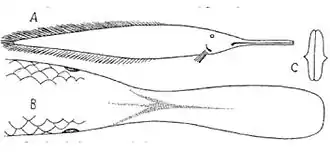Ompax spatuloides
Ompax spatuloides was a hoax fish "discovered" in Australia in August, 1872. Said to be poisonous, it could be found on some lists of Australian fishes through the 1930s.

The fish was a joke perpetrated by people at Gayndah station, Queensland, who prepared it from the body of a mullet, the tail of an eel and the head of a platypus or needlefish. They served it cooked for Karl Theodor Staiger, the director of the Brisbane Museum, and he forwarded a sketch and description of the fake to expert Francis de Laporte de Castelnau, who described the supposed "species" in 1879.[1] The first publication was in the proceedings of the Linnean Society of New South Wales,[2] in which Count Castelnau gave his description with figures reproducing the sketches executed at the time by "a draughtsman" at Staiger's request.[3] Doubts about the existence of the species were expressed as soon as 1881, when William John Macleay included it in a faunal list, but the name continued to appear throughout the twentieth century.[2][4]
Staiger is quoted as saying the fish was brought to him by indigenous people who had obtained it around ten miles away.[3] The components of the specimen were said by an anonymous confessor writing to the Sydney Morning Herald in 1930 to have been sourced from the tail of an eel, a mullet's body, and the head of an Australian lungfish. The last animal, the Australian lungfish, was an extraordinary fish whose existence had only become known to European researchers just a few years before. The addition of a platypus bill, seemingly shown in profile in Castelnau's accompanying figure, is also reported in the letter revealing the hoax.[5] In selecting the name of the genus, Castelnau says "In our present knowledge of this singular fish, some inconvenience might arise from giving it a significant name; and I think it is preferable to design it under the mysterious historical one of Ompax."[3]
References
- "A Mythical Fish". The Advocate. Burnie, Tas.: National Library of Australia. 17 January 1934. p. 5. Retrieved 19 September 2013.
- Macleay, W. (1881). "Descriptive catalogue of the fishes of Australia. Part IV". Proceedings of the Linnean Society of New South Wales. 6: 202–387. doi:10.5962/bhl.part.11870.
- Castelnau, F. (1879). "On a new ganoïd fish from Queensland". Proceedings of the Linnean Society of New South Wales. 3: 164–165. doi:10.5962/bhl.part.22233.
- Saunders, B. (2012). Discovery of Australia's Fishes: A History of Australian Ichthyology to 1930. Csiro Publishing. p. 126. ISBN 9780643106727.
- Helfman, G.; Collette, B.B.; Facey, D.E.; Bowen, B.W. (2009). The Diversity of Fishes: Biology, Evolution, and Ecology. John Wiley & Sons. p. 294. ISBN 9781444311907.
External links
- Australian Sporting Records (1998): 117. Bantam Books.
- Whitley, Gilbert P. (1933): Ompax spatuloides Castelnau, a mythical Australian fish. Am. Nat. 67(713): 563–567.